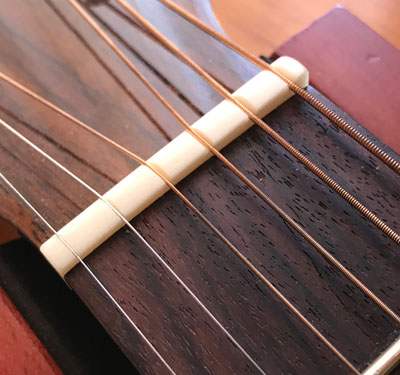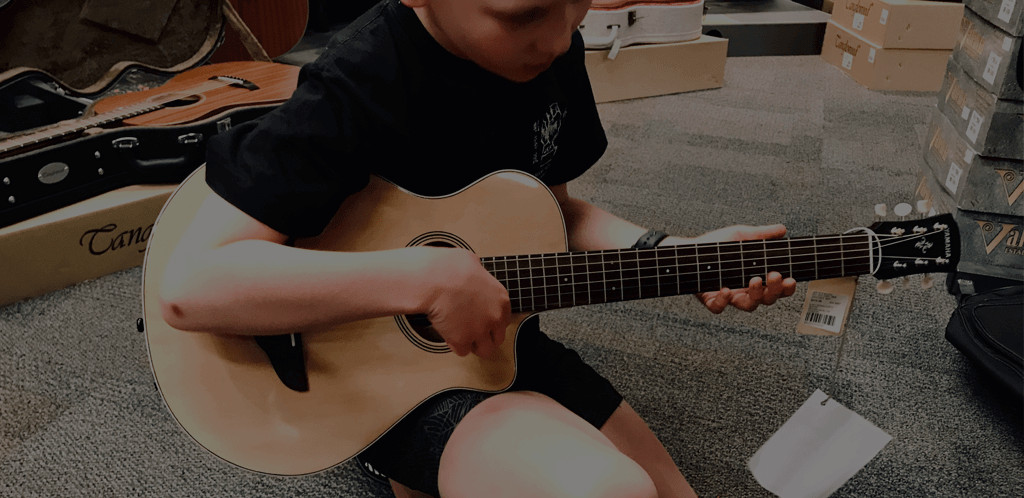Why a 1 3/4″ nut?

While there is no true industry standard here, every manufacturer likes to use their own special sizing to give themselves some identity.
The 1 3/4″ nut width is one of the more common sizes and offers a good ‘all around’ and safe option for the majority of players.
We less commonly see this nut width used on classical or nylon string guitars as most players require more room to play them effectively.
But for steel string instruments where each string produces a far higher amount of tension, they require far less room to vibrate. It works fine for both fingerstyle playing and strumming making it a versatile ‘one size fits all’ kind of nut size.
At first glance, you might think the string spacing on the nut determines the string spacing of the entire instrument, but this is only half correct. As the strings then run the length of the neck and to the bridge, it’s the correlation between the nut width and the saddle that determines the final string spacing.
So despite the nut width not being the only determining factor, it does heavily influence string spacing.
String spacing

An important factor to account for is that generally, the string spacing at the bridge is wider than that on the nut. So the strings will gradually taper out the further down the neck they travel and the string spacing at the bridge will be where they are further apart from each other.
In a practical sense, this makes plucking or playing fingerstyle easier as there is more space for the picking hand. The taper also allows the center of gravity of the neck to be closer to the body giving the guitar better overall balance.
How is nut width measured?
So specifically when referring to the nut width, we are not talking about the slots/grooves that the string sits in, nor are we talking about any measurement concerning string spacing (despite that being the primary reason why we use different-sized nuts).
The nut width refers exclusively to the measurement from the outside to the outside of the nut. This is a completely independent measurement from slots/string spacing.
Here’s a quick rundown of the most common sizes of nut used on acoustic guitars:
- 1 11/16” (43mm)
Considered the smallest of the nut sizes, used most commonly on steel string guitars, particularly 3/4 length models and those designed for kids. - 1 3/4“ (44mm)
The ‘standard’ nut size for the wider majority of steel string guitars. It works well for both strumming and fingerstyle, regardless of your hand size. The safest choice if you are unsure. - 1 13/16” (45mm)
Used primarily on steel string guitars but is far less common than the 1 3/4”, most often reserved for guitars with large bodies or custom builds. - 1 7/8“ (47mm)
A type of nut that is mainly geared towards fingerstyle players, can be used on both steel string and nylon guitars. You’ll find this on some gypsy jazz guitars. A guitar using this nut size may specifically be referred to as a ‘wide’ neck guitar. - 2” (51mm)
The largest standard nut size you will encounter and is primarily used for your typical classic nylon string guitar. You will rarely encounter a nut bigger than this on a typical production model.
What difference does nut width make?
So you may have read the previous section and thought to yourself “Well, there’s only a 1-2mm difference between all these nut sizes, does it really make a difference?”
The short answer is, yes.
Although the differences between these nut sizes might seem small on paper, in reality, these small differences can result in making a guitar feel quite different to play.
The effect of a different nut size for those with smaller hands can be very noticeable.
If you were to play, for example, a fingerstyle piece on a nut that’s too small, you wouldn’t be given a great deal of room to move your fingers.
This is why we increase the nut (and as a byproduct increase the string spacing) on classical guitars so you have enough room for your fingers and the breathing room needed to let the strings vibrate unimpeded.
Looking for an acoustic guitar with a 1 3/4 nut width? See below for a comprehensive list of guitars that use 1 ¾” inch nuts (the most common nut width you’ll encounter).
Martin D-28
A modern reimagining of the classic workhorse guitar used by legends such as The Beatles, Johnny Cash, and Bob Dylan.
It’s possibly the most famous guitar to use a 1 1 3/4“ nut and offers a nice blend of that classic 50/60’s D-series with some tweaks and updates to bring it up to speed for the modern player.
Martin D-18
Another Martin classic that combines that old-school 60s ethos with modern technology to provide a guitar that captures the spirit of the old but holds up to the rigours of the modern player.
Available with optional electronic systems should you wish.
* Click the image for the most up-to-date pricing
Taylor 414 series
Taylor’s 414 series is designed to be their lowest-priced Grand Auditorium guitar that features premium construction and wood choices which can handle almost any situation you put it in.
While we’d argue it’s not exactly a cheap instrument, for the level of quality it offers you’ll be hard-pressed to find such an exquisite instrument at such a good price.
Alvarez Artist Series AF30
While technically slightly wider than the 1 3/4 or 44mm nut length at 44.45, we still tend to put this in the same category. Some manufacturers just like to use their own unique sizing to establish identity – but it’s the same thing.
The Alvarez artist series is one of the best entry-level guitars around that utilize this nut width. It’s an award-winning guitar line and your first port of call if you are after this nut width on a budget.
Washburn WCG55CE
The Washburn comfort series is happy to throw away any preconceived notion of heritage and instead present a modern and refined acoustic that prioritizes efficiency and comfort over tradition.
It has a bevelled armrest, an in-built electronics system, and a sleek inlay-less ovangkol (we’ve never heard of it either) fingerboard. This is then paired with an all-Koa body to make an incredibly visually striking all-natural guitar.
Taylor 517/717
These are both pioneering guitar models that introduced the word to the Grand Pacific Body style. It features a mahogany back and sides complemented by a Sitka spruce top.
Additionally, it has what Taylor calls their ‘tone-boosting V-class bracing) which is supposed to increase tonal resonance and harmonic richness.
Epiphone Masterbilt EF-500R
No, that’s not a typo, the ‘masterbilt’ series from Epiphone Acoustics comes highly recommended by those who enjoy the 1 3/4“ nut size.
Described by Epiphone as a singer’s guitar, it has great projection, and warmth and lends itself very well to strumming.
Alvarez Masterworks Bluegrass Dread
Another guitar that uses the ever so slightly larger 44.45mm nut width. It’s a great mid-range instrument that comes in at just under $1000.
Ideal for the serious musician who’s also not looking to break the bank.
Blueridge BR-260
An updated version of the original 260A. It’s a modern take on a pre-war Herringbone guitar that has an incredible heritage and set the standard for guitars that followed over the subsequent decades.
Eastman E8D-TC
The E8D TC features a full-bone nut. This is complemented by a mahogany neck and an ebony fretboard.
The body is solid rosewood with a Sitka spruce top.
Eastman OM
A much more budget-friendly guitar that you can find used for just a few hundred dollars.
Although manufactured in China to cut production costs, they are great quality instruments with a beautiful, deep Sitka spruce top.
Recording King RO-26
Inspired by guitars of the ’30s with its AAA spruce top, old-school pickguard shape, and snowflake inlays.
If you’re interested in the classics this is one to check out!
The Recording King RP1-16C
Between the 1 3/4“ nut and its very small body, this is an ideal instrument for fingerpicking.
Inspired by the classic 1930s Gibson flattops which sounds incredibly good given its sub-$500 price tag.
Silver Creek T-160
Another fantastic Auditorium Acoustic which you can find on the used market for just a few hundred bucks.
It features similar wood choices to what you’d find on much more premium guitars and is a great gateway guitar into the higher-end Auditorium acoustics.
Tacoma DM-9
A uniquely square-looking Dreadnought guitar that has what Tacoma call their ‘tone shaped’ bridge, which is thicker on the bass side and thinner on the treble side.
How much of a difference does this make to the tone? No idea! But it certainly looks cool!
Stanford PSD10
Another budget-friendly guitar that you can find used for just a few hundred dollars. It features that classic old-school ‘paddle’ style headstock which gives it a nice vintage aesthetic.
* Click the image for the most up-to-date pricing
Voyage-Air VAOM-04
A pretty innovative instrument where the neck can be folded in so the guitar can be conveniently packed away for travel.
Certainly not an instrument for everyone, but if you’re on the move a lot and find yourself short on space – it could be just the thing!
* Click the image for the most up-to-date pricing
Yamaha LS6
The Yamaha L series is a great example of Yamaha doing what they do best, which is make incredibly good quality flat-top guitars that are inexpensive.
It’s got a great neutral style so whether you’re a modern or old-school guy this guitar will work for you.
Jasmine S35
A very clean and simple-looking Dreadnought acoustic that retails for just over $100. Ideal for first-time players and makes a great all-rounder instrument.
Alvarez Artist
Alvarez is one of those companies like Ibanez that use indecipherable codes for their guitar models. But if you search within their Artist series there are a number of fantastic 1 3/4“ guitars that can cater to any kind of style and preference you could want.
For being higher-end models they are also priced very reasonably too.
Sovereign Auditorium h1203
True vintage guitars that embody everything that made those traditional, American-made grand concert 000 guitars so great.
Despite being quite rare these days you’ll still find them being fixed up and sold on the used market for just a few hundred dollars. An exceptional price for how good they sound and that classic look people love so much.
Summary
Nut width might not be the first thing that comes to mind when thinking about what you want in your perfect guitar. It is, nevertheless, a factor that needs to be taken into consideration as it will affect how the guitar both feels and plays.
Fortunately, there is no shortage of these guitars on the market and hopefully, this list of acoustic guitars has given you some inspiration on what guitar you wish to purchase next.



